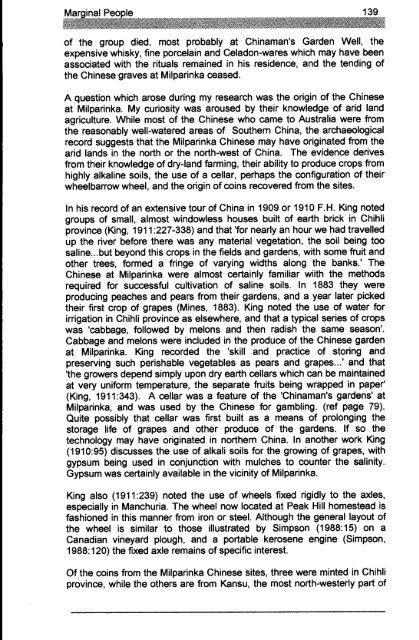Adec Preview Generated PDF File - The Sydney eScholarship ...
Adec Preview Generated PDF File - The Sydney eScholarship ...
Adec Preview Generated PDF File - The Sydney eScholarship ...
Create successful ePaper yourself
Turn your PDF publications into a flip-book with our unique Google optimized e-Paper software.
of the group died, most probably at Chinaman's Garden Well, the<br />
expensive whisky, fine porcelain and Celadon-wares which may have been<br />
associated with the rituals remained in his residence, and the tending of<br />
the Chinese graves at Milparinka ceased.<br />
A question which arose during my research was the origin of the Chinese<br />
at Milparinka. My curiosity was aroused by their knowledge of arid land<br />
agriculture. While most of the Chinese who came to Australia were from<br />
the reasonably well-watered areas of Southern China, the archaeological<br />
record suggests that the Milparinka Chinese may have originated from the<br />
arid lands in the north or the north-west of China. <strong>The</strong> evidence derives<br />
from their knowledge of dry-land farming, their ability to produce crops from<br />
highly alkaline soils, the use of a cellar, perhaps the configuration of their<br />
wheelbarrow wheel, and the origin of coins recovered from the sites.<br />
In his record of an extensive tour of China in 1909 or 1910 F.H. King noted<br />
groups of small, almost windowless houses built of earth brick in Chihli<br />
province (King, 1911 :227-338) and that 'for nearly an hour we had travelled<br />
up the river before there was any material vegetation, the soil being too<br />
saline...but beyond this crops in the fields and gardens, with some fruit and<br />
other trees, formed a fringe of varying widths along the banks.' <strong>The</strong><br />
Chinese at Milparinka were almost certainly familiar wiith the methods<br />
required for successful cultivation of saline soils. In 1883 they were<br />
producing peaches and pears from their gardens, and a year later picked<br />
their first crop of grapes (Mines, 1883). King noted the use of water for<br />
irrigation in Chihli province as elsewhere, and that a typical series of crops<br />
was 'cabbage, followed by melons and then radish the same season'.<br />
Cabbage and melons were included in the produce of the Chinese garden<br />
at Milparinka. King recorded the 'skill and practice of storing and<br />
preserving such perishable vegetables as pears and grapes...' and that<br />
'the growers depend simply upon dry earth cellars which can be maintained<br />
at very uniform temperature, the separate fruits being wrapped in paper'<br />
(King, 1911:343). A cellar was a feature of the 'Chinaman's gardens' at<br />
Milparinka, and was used by the Chinese for gambling. (ref page 79).<br />
Quite possibly that cellar was first built as a means of prolonging the<br />
storage life of grapes and other produce of the gardens. If so the<br />
technology may have originated in northern China. In another work King<br />
(1910:95) discusses the use of alkali soils for the growing of grapes, with<br />
gypsum being used in conjunction with mulches to counter the salinity.<br />
Gypsum was certainly available in the vicinity of Milparinka.<br />
King also (1911 :239) noted the use of wheels fixed rigidly to the axles,<br />
especially in Manchuria. <strong>The</strong> wheel now located at Peak Hill homestead is<br />
fashioned in this manner from iron or steel. Although the general layout of<br />
the wheel is similar to those illustrated by Simpson (1988:15) on a<br />
Canadian vineyard plough, and a portable kerosene engine (Simpson,<br />
1988:120) the fixed axle remains of specific interest.<br />
Of the coins from the Milparinka Chinese sites, three were minted in Chihli<br />
province, while the others are from Kansu, the most north-westerly part of




